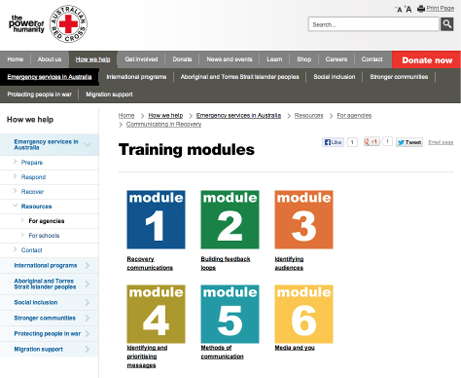
Contributed by Lauren Gould of the Australian Red Cross
In 2011, the Red Cross released Communicating in Recovery - an all-hazards, best-practice guide aimed at those working with disaster-affected communities. The guide was developed after the 2009 Victorian bushfires and following consultation with communities and government agencies to identify gaps within the recovery sector. Communication was highlighted as a constant challenge that created barriers for those receiving and disseminating information. In direct response to this, Red Cross identified a need for, and have since produced, this practical guide to effective post-disaster communication.
Communicating in Recovery was hailed as the ‘first of its kind’ internationally when it was first released, partly because recovery communication is rarely recognised as a niche area that requires unique skills. Red Cross consultations indicated that effectively managing information after a disaster can often be just as difficult as responding to the event itself. One of the major challenges of communicating in a post-emergency environment is that the very people who become responsible for managing information often have limited or no formal training in communication or recovery. It is critical that a recovery workforce is skilled in identifying and responding to the needs of audiences during times of disaster recovery to ensure that communities are informed and connected. Access to quality information before, during and after an emergency can have a profound effect on the resilience and recovery of individuals and their communities.
After receiving positive feedback about Communicating in Recovery, the next step was to ensure the guide was regarded as a practical tool that could strengthen the recovery sector. The Bendigo Bank Community Enterprise Foundation provided funding to scope a range of professional development activities which would reinforce the messages in Communicating in Recovery.
Extensive consultation with key stakeholders informed the development of six training modules which were co-written by media consultant Steve Ahern, and two staff, Loren Hackett and Lauren Gould, from the Red Cross Emergency Recovery team. The modules were based on content from the guide and the training was designed in a workshop format. A working group was established to guide the initial development of the training and included representatives from ABC Local Radio, the Australian Emergency Management Institute, and the Red Cross.
Two pilot workshops were held in Melbourne in late 2011 to test the training materials. Participants represented a broad spectrum of the emergency management and community sectors, including local and state governments, community leaders, emergency services providers and community organisations. Valuable feedback was used to improve training content before officially commencing delivery.
The guide is the primary training resource. To ensure it is accessible and practical in a post-emergency environment, workshop participants are asked to consider how group activities, case studies, examples and anecdotes could be applied to their own work or community context. The workshop allows participants time to discuss their own experiences, hear other people’s stories, and connect with others working in the sector.

Image: Red Cross
Communicating in Recovery is an all-hazards, best-practice guide.
Training is available in four formats and is flexible and tailored for particular groups. These are:
Anyone who is involved in communicating with disaster-effected audiences can attend the training. This may include senior management or staff working in recovery, communication or community engagement activities. Business and community leaders are welcome as are other people who play a key role in their community like sports club coaches, teachers, religious or cultural leaders.
In Victoria, local government has been targeted as a priority audience. Councils are encouraged to identify organisation representatives or community leaders who may be involved in emergency recovery. This provides an opportunity to network and balance the learning dynamic. Emergency response agencies such as Victoria Police and the Victorian State Emergency Service have also attended the workshops. This is a positive step in strengthening relationships between response and recovery agencies.
Official training delivery commenced in Victoria in early 2012 while national training delivery commenced later that year. To date, over 350 people have been trained in 23 workshops across Victoria, New South Wales, Tasmania and Western Australia. As a result of the training participant feedback has been that:
The Communicating in Recovery website was launched in February 2012 and has been further developed as an online learning hub which hosts training module content, video case studies, and a research and template library.
The training is being promoted as key sector training by the International Federation of the Red Cross and the international Communicating with Disaster Affected Communities Network. Red Cross colleagues in New Zealand are also interested in providing the training to recovery workers in the Canterbury region.

Image: Red Cross
The Red Cross website has all the information about the training modules.
Subject to funding, the Red Cross would like to expand its target audiences in the future to include corporate and philanthropic organisations, media, universities, and state/territory and federal government departments.
The Red Cross continues to measure the impact of the training on the recovery workforce and disaster-affected communities. Feedback is collected after each workshop and a post-training survey is sent to participants to measure the training’s impact in the field. External evaluation is planned for 2014/15 to assess if participants have gained skills and knowledge to communicate more effectively and positively impact emergency-affected communities.
For training dates or to register interest in the training, visit www.redcross.org.au/communicatinginrecovery.